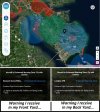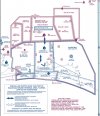It is not illegal to fly in controlled airspace with ATC clearance under part 107. LAANC gives you this clearance.
That statement is not entirely true, if the airspace is within the controlled Class D airspace of a military installation, LAANC is not available and you (recreational and Part 107 Pilots) want to fly there, you are required to get an authorization through the FAADroneZone. And if the Airport is not LAANC Enabled (of the more than 5,000 airports in the US, only approximately 725 are LAANC Enabled…) then those same pilots must apply for an authorization and before flying that controlled airspace, they must call and coordinate their flying with the Air Traffic Control (ATC) facility…
I completed the Careers Studies Certificate in Unmanned Aerial Systems course at Virginia Peninsula Community College (VPCC) and the campus is well inside the Class D Airspace of Langley AFB and the college had to get an authorization for us to fly in their parking lot and before we flew they called Langley ATC to coordinate our flights and call when we were finished flying (as a side note, half of the parking lot was covered by a DJI Geo Fence due to its proximity to Langley).
Additionally, if a student is going to be piloting a drone, even under the direct supervision of a Part 107 Licensed Pilot who is acting as Pilot in Charge (PIC), the student would still be required to have a TRUST Certificate (A requirement for all in the program at VPCC and the college kept a copy on file…).
Case in point… the FAA Says, "Drones flown for educational purposes are regulated under the Exception for Limited Recreational Operations of Unmanned Aircraft or under the Small Unmanned Aircraft Systems Rule."
Admittedly, flying within a structure (ie: gymnasium) does mitigate some FAA Rules, however, even if one suggests flying in a FAA-Recognized Identification Areas (FRIAs), all the rules except the Remote Identification requirement apply…
For me just to fly in my own yard, I live in a Zero Altitude Quadrant, and I had to get my Part 107 to get an FAA authorization. They never granted one to me when I was a Rec Pilot… And practically everywhere I fly requires an FAA or a LAANC Authorization… See my home turf map below…













